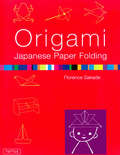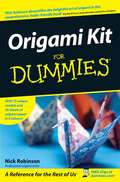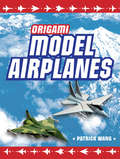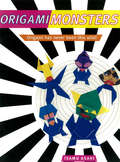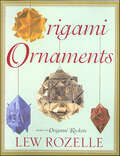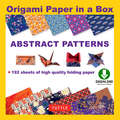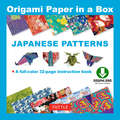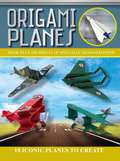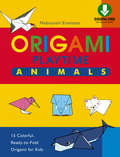- Table View
- List View
Origami Japanese Paper-Folding
by Florence SakadeOrigami Japanese Paper-Folding features 50 items, ranging from simple to more difficult. These include various animals, flowers, boxes, boats and the ever popular crane. A section on practical applications shows how origami can be used in mobiles, as party decorations, and for games. Each Origami item is explained with diagrams and clear easy to follow instructions, and the finished items are shown in photographs. This book on the delightful art of origami is sure to provide hours of creative entertainment for both children and adults.
Origami Japanese Paper-Folding
by Florence SakadeOrigami Japanese Paper-Folding features 50 items, ranging from simple to more difficult. These include various animals, flowers, boxes, boats and the ever popular crane. A section on practical applications shows how origami can be used in mobiles, as party decorations, and for games. Each Origami item is explained with diagrams and clear easy to follow instructions, and the finished items are shown in photographs. This book on the delightful art of origami is sure to provide hours of creative entertainment for both children and adults.
Origami Jewelry
by Richard L. Alexander Michael G. LafosseMake your own origami jewelry! In this new paper craft book from world renowned origami artists, Michael G. LaFosse and Richard L. Alexander, you'll be delighted to discover how quick, fun and inexpensive it is to make durable DIY jewelry that you'll actually be able to wear! LaFosse & Alexander's Origami Jewelry will show you how to create 3D designs to go with your hair, skin, and wardrobe by customizing the components to your own personal fashion. A full-color easy-to-follow book, clear diagrams and the included DVD provides you step-by-step instructions to create lovely pendants, medallions, charms, bracelets, necklaces and earrings in minutes. The origami paper and other materials needed are inexpensive and available in any craft store and a simple starch-based paste will provide your jewelry with remarkable strength to last for years.
Origami Jewelry (Dover Crafts: Origami & Papercrafts)
by Mayumi Jezewski"This was everything I hoped it would be. Excellent directions both written and with images. Beautiful photos. A full list of items needed for each piece. The instructions are very clear." — Books Under the BedYou can design your own jewelry with the help of this easy-to-follow guide. More than 35 lovely accessories include a bracelet of hearts, spring flower earrings, hairpins with butterfly ornaments, and other whimsical, wearable origami.Each of the models features clear, step-by-step instructions with full-color illustrations for folding the dainty charms. The directions also show how to embellish the jewelry with beads and other ornaments, and how to attach the items to chains and clips. The necessary materials are inexpensive and readily available at craft shops. Origami jewelry is as much fun to make as it is to wear, and you'll love creating handcrafted treasures that you can keep or share with your friends.
Origami Jungle
by Michael G. LafosseMake colorful and simple origami animals and their jungle habitats with this easy origami ebook. Anteaters, Chameleons, Lemurs and Lizards are just a few of the fierce and beautiful origami jungle animals you can create with this paper craft origami ebook. World renowned origami author and artist Michael LaFosse provides origami enthusiasts a jungle themed paper craft ebook that both beginner and advanced folders will enjoy. Origami Jungle includes everything needed to get started in folding traditional designs and original creations to make elegant paper arrangements of jungle animals, vines and trees for gifts or decorations. Use it to craft eye-catching origami for your friends, to beautify your home-or as a wonderful gift for animal lovers. All of the folds are simple enough to be origami-for-kids projects and are a great way to learn origami. This origami ebook contains: 2 full-colored, 32-page booklets Clear step-by-step instructions Easy-to-follow diagrams 42 simple origami jungle projects Origami Jungle provides you this stunning collection of origami projects that will have you creating your own personal tropical nature preserve in no time! Origami projects include: Tree Sloth Crocodile Iguana Toucan Piranha And many more...
Origami Jungle
by Michael G. LafosseMake colorful and simple origami animals and their jungle habitats with this easy origami ebook.Anteaters, Chameleons, Lemurs and Lizards are just a few of the fierce and beautiful origami jungle animals you can create with this paper craft origami ebook. World renowned origami author and artist Michael LaFosse provides origami enthusiasts a jungle themed paper craft ebook that both beginner and advanced folders will enjoy. Origami Jungle includes everything needed to get started in folding traditional designs and original creations to make elegant paper arrangements of jungle animals, vines and trees for gifts or decorations. Use it to craft eye-catching origami for your friends, to beautify your home-or as a wonderful gift for animal lovers.All of the folds are simple enough to be origami-for-kids projects and are a great way to learn origami. This origami ebook contains: 2 full-colored, 32-page booklets Clear step-by-step instructions Easy-to-follow diagrams 42 simple origami jungle projectsOrigami Jungle provides you this stunning collection of origami projects that will have you creating your own personal tropical nature preserve in no time!Origami projects include: Tree Sloth Crocodile Iguana Toucan Piranha And many more...
Origami Jungle
by Michael G. LafosseMake colorful and simple origami animals and their jungle habitats with this easy origami kit. Anteaters, Chameleons, Lemurs and Lizards are just a few of the fierce and beautiful origami jungle animals you can create with this paper craft origami kit. World renowned origami author and artist Michael LaFosse provides origami enthusiasts a jungle themed paper craft kit that both beginner and advanced folders will enjoy. Origami Jungle Kit includes everything needed to get started in folding traditional designs and original creations to make elegant paper arrangements of jungle animals, vines and trees for gifts or decorations. Use it to craft eye-catching origami for your friends, to beautify your home—or as a wonderful gift for animal lovers. All of the folds are simple enough to be origami-for-kids projects and are a great way to learn origami. The origami paper in the kit already has printed patters so no paint or glue is required, just unpack and start folding right away! This origami kit contains: 2 full-colored, 32-page booklets Clear step-by-step instructions Easy-to-follow diagrams 42 simple origami jungle projects 96 sheets of durable authentic origami folding paper A variety of different colors and patterns 2 sheets of gold foil Origami Jungle Kit provides you this stunning collection of origami projects that will have you creating your own personal tropical nature preserve in no time! Origami projects include: Tree Sloth Crocodile Iguana Toucan Piranha And many more. . .
Origami Kit For Dummies
by Nick RobinsonOrigami Kit For Dummies gives you all the material you need to get started in origami. Included in the kit is an expert guide book to origami, covering the different bases and techniques you need to create a huge variety of models. Illustrations and detailed instructions show you how to make 75 unique models, such as a frog, a settee, fantastic geometric shapes and even a festive Santa! There are also 25 sheets of 5x5" origami paper in five fun colours. So get folding, and show off your creations in style!Discover How To:* Get prepared to start folding* Understand the international language of origami* Fold all the basic bases* Source your paper* Design creations and draw your own diagramsAbout the authorNick Robinson is a professional origami artist, and has been "folding paper" for 25 years. He has been a member of the British Origami Society for over 20 years, and currently he edits their magazine, as well as maintaining their website.
Origami Made Simple: 40 Easy Models with Step-by-Step Instructions
by Russell WoodSpark a lifetime of creativity with a few sheets of paper!Discover the art of paper folding with Origami Made Simple. Featuring 40 classic and original origami models, complete with detailed diagrams and written instructions for every step, it's the fastest way for you to start creating eye-catching paper sculptures.If you're new to origami, the iconic yet approachable designs in this book are a great way to hone your skills—and have a blast doing it. Start with straightforward models that take 10 steps or less and work your way up to more complex creations. No matter the level of difficulty, every model is diagrammed for ease of use, with tricky folds highlighted and broken down into multiple steps.This origami book includes:Classic and contemporary—Try your hand at recognizable models, like Crane and Sailboat, as well as original designs, like Cobra and Teapot.Tips and techniques—Pay attention to tips that help you select the right paper, work through tough steps, and add your own creative twist.Symbol glossary—Find a comprehensive guide to standard origami symbols, as well as helpful info on how to read origami diagrams.Fold up some fun with Origami Made Simple!
Origami Model Airplanes
by Patrick WangNow you can create amazingly detailed model airplanes using basic origami techniques! Have you ever marveled at the intricate design work of a model plane? Or dreamed about making one, but been intimidated by the long and complicated directions? If so, then Origami Model Airplanes is the book for you!Expert folder Patrick Wang provides illustrated instructions for 23 original paper airplanes. Not only has he created designs for truly eye-catching paper planes, he's also devised a unique system for making them that is less time consuming and frustrating, even for absolute newcomers to the art of paperfolding. Experienced folders will marvel that the most realistic model airplanes available today can be made using just familiar origami methods. In addition to multiple photos of the finished fighter jet models and other military planes, numerous facts are given for each of the planes these models so realistically depict.Take a chance with Origami Model Airplanes and prepare to stupefy and impress all who see them. No one will ever believe these intricate-looking model airplanes take just a nimble set of fingers, a pair of scissors and a bit of glue to make.
Origami Model Airplanes
by Patrick WangNow you can create amazingly detailed model airplanes using basic origami techniques! Have you ever marveled at the intricate design work of a model plane? Or dreamed about making one, but been intimidated by the long and complicated directions? If so, then Origami Model Airplanes is the book for you!Expert folder Patrick Wang provides illustrated instructions for 23 original paper airplanes. Not only has he created designs for truly eye-catching paper planes, he's also devised a unique system for making them that is less time consuming and frustrating, even for absolute newcomers to the art of paperfolding. Experienced folders will marvel that the most realistic model airplanes available today can be made using just familiar origami methods. In addition to multiple photos of the finished fighter jet models and other military planes, numerous facts are given for each of the planes these models so realistically depict.Take a chance with Origami Model Airplanes and prepare to stupefy and impress all who see them. No one will ever believe these intricate-looking model airplanes take just a nimble set of fingers, a pair of scissors and a bit of glue to make.
Origami Monsters
by Isamu AsahiGreen Gremlin, Cyclops, Bat Bird, and hatted Tetra Garper are just four of the many colorful monsters you will create with this ghoulishly fun book of Japanese paper folding. Easy-to-follow numbered diagrams enable even beginners to construct some of the spookiest creatures this side of Mars.
Origami Monsters
by Isamu AsahiGreen Gremlin, Cyclops, Bat Bird, and hatted Tetra Garper are just four of the many colorful monsters you will create with this ghoulishly fun book of Japanese paper folding. Easy-to-follow numbered diagrams enable even beginners to construct some of the spookiest creatures this side of Mars.
Origami Note Cards
by Florence TemkoMake fun and useful homemade note cards with this easy origami ebook.Anyone receiving a note folded up in a mysterious way will get an extra lift of anticipation. Origami Note Cards shows how to fold paper into all kinds of different shapes. Instead of searching for a printed greeting card at a store, you may enjoy spending a few minutes folding a piece of ordinary paper into a very personal origami message.Origami Note Cards is the perfect beginning origami ebook for crafting your own distinctive greeting cards and notes. With just a few folds, you can create unforgettable personalized cards that will let the recipient know how much you care. Perfect for birthdays, thank you notes, Christmas, Valentine's Day and just about any occasion, these beautiful folded origami note cards will make special surprises for your favorite people. You'll even learn how to make blank books just right for sharing, and origami envelopes perfect for mailing your creations. This makes a great origami for kids book and is an easy way learn origami. The folding patterns range from very simple, needing only four or five creases, to more challenging.The origami ebook contains:A full-colored 48-page origami book Clear step-by-step
Origami Odyssey
by Peter Engel Nondita Correa-MehrotraRenowned origami artist Peter Engel first astounded origami enthusiasts and the lay person alike with his popular Origami from Angelfish to Zen. Since that book, published in 1989, Engel has gone through a personal change in his philosophy of origami design, honed through decades of elevating what is often viewed as simple paper folding into a fine art.In Origami Odyssey, Engel takes paper crafters on a journey to the edge of paper folding, providing instruction for exquisite and original origami designs, including several that have been shown in galleries and museums throughout the world. Experienced folders will delight in the chance to grow as artists as they master the projects in this book, and new comers to origami will find the author's journey so inspiring that they'll be ready to begin an odyssey of their own.This unique do-it-yourself paper craft book includes:Full-colored photos and step-by-step instructions and diagrams21 fun-to-do projects like the Green Horned Owl, Gingko Leaf, Stingray and much more!Downloadable material included
Origami Odyssey
by Peter EngelRenowned origami artist Peter Engel first astounded origami enthusiasts and the lay person alike with his popular Origami from Angelfish to Zen. Since that book, published in 1989, Engel has gone through a personal change in his philosophy of origami design, honed through decades of elevating what is often viewed as simple paper folding into a fine art. In Origami Odyssey, Engel takes paper crafters on a journey to the edge of paper folding, providing instruction for exquisite and original origami designs, including several that have been shown in galleries and museums throughout the world. Experienced folders will delight in the chance to grow as artists as they master the projects in this book, and new comers to origami will find the author's journey so inspiring that they'll be ready to begin an odyssey of their own. This unique do-it-yourself paper craft book includes:Full-colored photos and step-by-step instructions and diagrams21 fun-to-do projects like the Green Horned Owl, Gingko Leaf, Stingray and much more!An instructional DVD with easy-to-follow video tutorials
Origami Odyssey
by Peter EngelRenowned origami artist Peter Engel first astounded origami enthusiasts and the lay person alike with his popular Origami from Angelfish to Zen. Since that book, published in 1989, Engel has gone through a personal change in his philosophy of origami design, honed through decades of elevating what is often viewed as simple paper folding into a fine art. In Origami Odyssey, Engel takes paper crafters on a journey to the edge of paper folding, providing instruction for exquisite and original origami designs, including several that have been shown in galleries and museums throughout the world. Experienced folders will delight in the chance to grow as artists as they master the projects in this book, and new comers to origami will find the author's journey so inspiring that they'll be ready to begin an odyssey of their own. This unique do-it-yourself paper craft book includes:Full-colored photos and step-by-step instructions and diagrams21 fun-to-do projects like the Green Horned Owl, Gingko Leaf, Stingray and much more!Downloadable material included
Origami Ornaments
by Lew RozelleBased on the design of traditional Japanese Kusudama ceremonial spheres, Origami Ornaments offers step-by-step instructions on how to create colorful paper folding decorations--from disco balls and unique cubes to lovely globe and lantern shapes--while remaining true to origami purist standards. Featuring four basic model designs--base, joiner, clip, and hinge--that can create limitless, unique ornaments, this orgiami book offers do-it-yourself designs small enough to hang on a Christmas tree or large enough to hold aromatic potpourri. As the ornaments rest they will open gently, like flowers, but still not come apart. Additional instructions for incorporating strings and tassels, as well as suggestions for utilizing different wrapping paper colors and patterns, will make these original ornaments dazzle.Origami Ornaments is the perfect book for holiday crafters and origami enthusiasts alike.
Origami Paper in a Box: Abstract Patterns
by Vanda Battaglia Francesco DecioJapanese patterns are elegant, colorful and unique. Origami Paper in a Box takes exciting, abstract patterns and transforms them into origami folding paper. These paper packs make a great resource for all different kinds of folding, crafting and scrapbooking projects. The package includes folding sheets as well as a booklet with instructions so that folders can start right away.
Origami Paper in a Box: Japanese Patterns
by Vanda Battaglia Francesco DecioJapanese patterns are elegant, colorful and unique. Origami Paper in a Box takes traditional Japanese patterns and transforms them into origami folding paper. These paper packs make a great resource for all different kinds of folding, crafting and scrapbooking projects. The package includes folding sheets as well as a booklet with instructions so that folders can start right away.
Origami Party Time
by Florence TemkoProvides a collection of party decorations. This origami kit includes projects such as Pop-Up Invitation, Candydish, Butterfly Table Decoration, Napkin Fold, Tissue Paper Flower, Pull-my-Tail Action Toy, and many more. It also contains: a 48-page book with instructions and diagrams for 25 different projects, 98 sheets of folding paper; and more.
Origami Party Time!
by Florence TemkoFull of unique ideas and projects, the models are sure to add a sense of fun and flair to any occasion! Origami Party Time makes it easy to create simple, one-of-a-kind decorations, table settings, and party favors for your special event. Perfect for entertaining kids and adults, these whimsical paper invitations, bowls, baskets, toys, games, and prizes will add a charming twist to any party or event. The decorations are easily transportable to a party at a different location, where they can be restored to three-dimensional form. If desired, they can be stored flat to be used again.
Origami Planes (Origami Books)
by Daniel Robinson Seth Friedman Jason Ku Marc KirschenbaumThe latest innovation in paper airplanes!Your spirits will soar as you fold up these ten origami models! An exciting challenge, this kit will appeal to aviation enthusiasts and origami artists alike. Watch your very own hangar of model airplanes unfold before your eyes as you follow the step-by-step directions and detailed diagrams in the 80-page instruction book. Specially designed paper makes these models better than any other paper airplane. A fun and interactive way to enhance aircraft recognition and learn aviation history, this kit will leave you flying high!
Origami Playtime Animals
by Nobuyoshi EnomotoFeaturing 15 tear-out, ready-to-fold projects, this is an introduction to the Japanese paper-folding art of origami. This collection of animal designs includes an elephant, a songbird, a fox, and many more designs for children.
Origami Playtime Book 1 Animals
by Nobuyoshi EnomotoOrigami Playtime Book 1 Animals contains 15 colorful , ready-to-fold origami for kids. You'll fold cats, dogs, birds, fish, frogs, and many other wonderful creatures.
